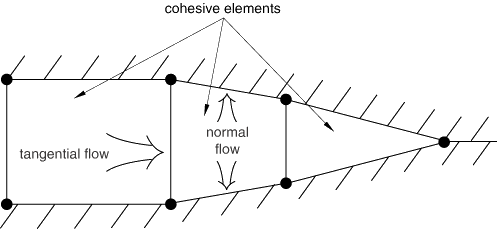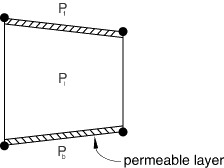Defining the constitutive response of fluid within the cohesive element gap | ||
| ||
ProductsAbaqus/StandardAbaqus/CAE
Defining pore fluid flow properties
The fluid constitutive response comprises:
Tangential flow within the gap, which can be modeled with either a Newtonian or power law model; and
Normal flow across the gap, which can reflect resistance due to caking or fouling effects.
The flow patterns of the pore fluid in the element are shown in Figure 1.

The fluid is assumed to be incompressible, and the formulation is based on a statement of flow continuity that considers tangential and normal flow and the rate of opening of the cohesive element.
![]()
Specifying the fluid flow properties
You can assign tangential and normal flow properties separately.
Tangential flow
By default, there is no tangential flow of pore fluid within the cohesive element. To allow tangential flow, define a gap flow property in conjunction with the pore fluid material definition.
Newtonian fluid
In the case of a Newtonian fluid the volume flow rate density vector is given by the expression
where is the tangential permeability (the resistance to the fluid flow), is the pressure gradient along the cohesive element, and is the gap opening.
In Abaqus the gap opening, , is defined as
where and are the current and original cohesive element geometrical thicknesses, respectively; and is the initial gap opening, which has a default value of 0.002.
Abaqus defines the tangential permeability, or the resistance to flow, according to Reynold's equation:
where is the fluid viscosity and is the gap opening. You can also specify an upper limit on the value of .
Input File Usage
Use the following option to define the initial gap opening directly:
SECTION CONTROLS, INITIAL GAP OPENING
Use the following option to define the tangential flow in a Newtonian fluid:
GAP FLOW, TYPE=NEWTONIAN, KMAX
Abaqus/CAE Usage
Initial gap opening is not supported in Abaqus/CAE.Property module: material editor: : Type: Newtonian: Toggle on Maximum Permeability and enter the value of
Power law fluid
In the case of a power law fluid the constitutive relation is defined as
where is the shear stress, is the shear strain rate, is the fluid consistency, and is the power law coefficient. Abaqus defines the tangential volume flow rate density as
where is the gap opening.
Input File Usage
GAP FLOW, TYPE=POWER LAW
Abaqus/CAE Usage
Property module: material editor: : Type: Power law
Normal flow across gap surfaces
You can permit normal flow by defining a fluid leak-off coefficient for the pore fluid material. This coefficient defines a pressure-flow relationship between the cohesive element's middle nodes and their adjacent surface nodes. The fluid leak-off coefficients can be interpreted as the permeability of a finite layer of material on the cohesive element surfaces, as shown in Figure 2.

The normal flow is defined as
and
where and are the flow rates into the top and bottom surfaces, respectively; is the midface pressure; and and are the pore pressures on the top and bottom surfaces, respectively.
Input File Usage
Abaqus/CAE Usage
Property module: material editor: : Type: Coefficients
Defining leak-off coefficients as a function of temperature and field variables
You can optionally define leak-off coefficients as functions of temperature and field variables.
Input File Usage
FLUID LEAKOFF, DEPENDENCIES
Abaqus/CAE Usage
Property module: material editor: : Type: Coefficients: Toggle on Use temperature-dependent data and select the number of field variables.
Defining leak-off coefficients in a user subroutine
User subroutine UFLUIDLEAKOFF can also be used to define more complex leak-off behavior, including the ability to define a time accumulated resistance, or fouling, through the use of solution-dependent state variables.
Input File Usage
FLUID LEAKOFF, USER
Abaqus/CAE Usage
Property module: material editor: : Type: User
Tangential and normal flow combinations
Table 1 shows the permitted combinations of tangential and normal flow and the effects of each combination.
| Normal flow is defined | Normal flow is undefined | |
|---|---|---|
| Tangential flow is defined | Tangential and normal flow are modeled. | Tangential flow is modeled. Pore pressure continuity is enforced between facing nodes in the cohesive element only when the element is closed. Otherwise, the surfaces are impermeable in the normal direction. |
| Tangential flow is undefined | Normal flow is modeled. | Tangential flow is not modeled. Pore pressure continuity is always enforced between facing nodes in the cohesive element. |
![]()
Initially open elements
When the opening of the cohesive element is driven primarily by entry of fluid into the gap, you will have to define one or more elements as initially open, since tangential flow is possible only in an open element. Identify initially open elements as initial conditions.
Input File Usage
INITIAL CONDITIONS, TYPE=INITIAL GAP
Abaqus/CAE Usage
Initial gap definition is not supported in Abaqus/CAE.
![]()
Use of unsymmetric matrix storage and solution
The pore pressure cohesive element matrices are unsymmetric; therefore, unsymmetric matrix storage and solution may be needed to improve convergence (see Matrix storage and solution scheme in Abaqus/Standard).
![]()
Additional considerations
Your use of cohesive element fluid properties and your property values can impact your solution in some cases.
Large coefficient values
You must make sure that the tangential permeability or fluid leak-off coefficients are not excessively large. If either coefficient is many orders of magnitude higher than the permeability in the adjacent continuum elements, matrix conditioning problems may occur, leading to solver singularities and unreliable results.
Use in total pore pressure simulations
Definition of tangential flow properties may result in inaccurate results if the total pore pressure formulation is used and the hydrostatic pressure gradient contributes significantly to the tangential flow in the gap. The total pore pressure formulation is invoked if you apply gravity distributed loads to all elements in the model. The results will be accurate if the hydrostatic pressure gradient (i.e., the gravity vector) is perpendicular to the cohesive element.
![]()
Output
The following output variables are available when flow is enabled in pore pressure cohesive elements:
- GFVR
Gap fluid volume rate.
- PFOPEN
Fracture opening.
- LEAKVRT
Leak-off flow rate at element top.
- ALEAKVRT
Accumulated leak-off flow volume at element top.
- LEAKVRB
Leak-off flow rate at element bottom.
- ALEAKVRB
Accumulated leak-off flow volume at element bottom.